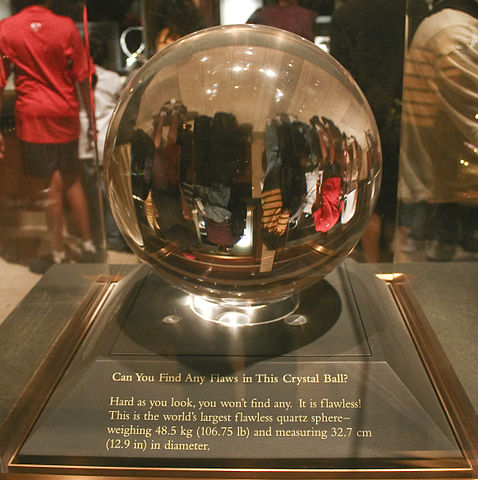Crystal ball
A crystal ball, also known as an orbuculum or crystal sphere, is a crystal or glass ball and a common fortune-telling object. It is generally associated with divination and scrying in particular.
History
In the 1st century CE, Pliny the Elder describes the use of crystal balls by soothsayers (crystallum orbis, later written in Medieval Latin by scribes as orbuculum). By the 5th century CE, scrying was widespread within the Roman Empire and was condemned by the early medieval Christian Church as heretical.
Dr. John Dee was a noted British mathematician, astronomer, astrologer, geographer, and consultant to Queen Elizabeth I. He devoted much of his life to alchemy, divination, and Hermetic philosophy, of which the use of crystal balls was often included.
Crystal gazing was a popular pastime in the Victorian era and was claimed to work best when the Sun is at its northernmost declination. Immediately before the appearance of a vision, the ball was said to mist up from within.
Properties
A crystal ball is essentially a bi-convex spherical lens with a uniform radius of curvature, although without its edges and center material truncated as in conventional lens construction. Thus the principles of optics may be applied to analyze its imaging characteristics. As a lens, a transparent sphere of any material with a refractive index greater than one bends rays of light to a focal point. An image is formed with significant coma, field curvature, and other optical aberrations inherent to spherical lenses. The refractive index of typical materials used for crystal balls (quartz: 1.46, window glass: 1.52), produces a central focal point just outside the surface of the sphere, on the side diametrically opposite to where the rays entered.
Since a crystal ball has no edges like a conventional lens, the image-forming properties are omnidirectional (independent of the direction being imaged). This effect is exploited in the Campbell–Stokes recorder, a scientific instrument that records the brightness of sunlight by burning the surface of a paper card bent around the sphere. The device, itself fixed, records the apparent motion and intensity of the sun across the sky, burning an image of the sun's motion across the card.
The omnidirectional burning glass effect can occur with a crystal ball that is brought into full sunlight. The image of the sun formed by a large crystal ball will burn a hand that is holding it and can ignite dark-colored flammable material placed near it.
